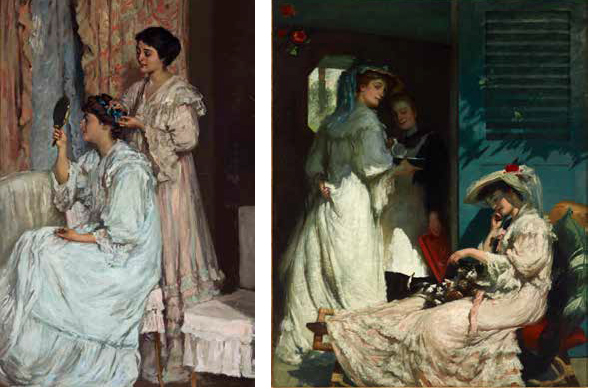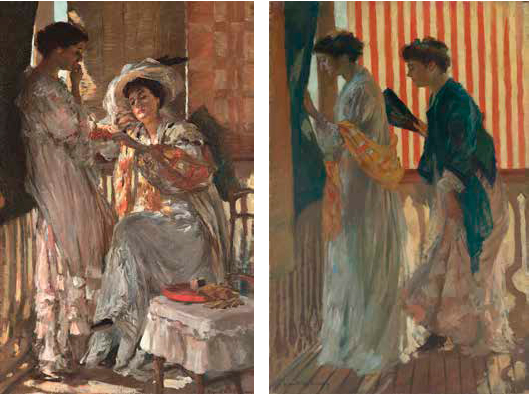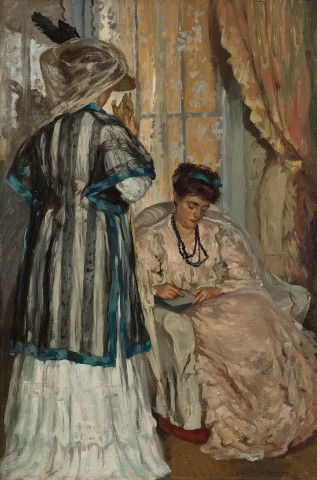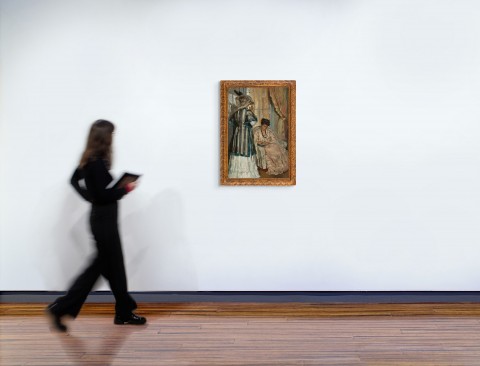THE TELEGRAM, c.1908
RUPERT BUNNY
oil on canvas
81.0 x 54.0 cm
signed lower right: Rupert C W Bunny.
bears inscription on label verso: no. 155 / The Telegram
original Paris frame
Mr and Mrs John Rowell, Melbourne
McClelland Collection, McClelland Sculpture Park and Gallery, Langwarrin, gifted by Mrs Jean Rowell and Mrs Ackland in memory of John Rowell, 24 November 1977 (label attached verso)
Société Internationale de Peinture et de Sculpture, Galeries Georges Petit, Paris, 5 – 31 December 1908, cat. 28 (as 'Le Télégramme')
'Days and Nights in August' by Rupert Bunny, The Baillie Gallery, London, 22 April – 12 May 1911, cat. 16
Exhibition of Pictures by Rupert Bunny, Athenaeum Hall, Melbourne, 24 July – 14 August 1911, cat. 22
Exhibition of Pictures by Rupert Bunny, Lawson & Little Galleries, Sydney, 22 September – 1 October 1911
Paintings by Rupert Bunny from Private Collections, McClelland Gallery, Langwarrin, 25 November 1972 – 8 February 1973, cat. 4
All Our Own Work, McClelland Gallery, Langwarrin, December 1977 – January 1978, cat. 14
All Our Own Work, McClelland Gallery, Langwarrin, 8 – 31 July 1979, cat. 17
'Quiet, Faithful Art. Mr Rupert Bunny's Exhibition,' The Sun, Sydney, 22 September 1911, p. 8
Gérard-Austin, A., The Greatest Voyage: Australian Painters in the Paris Salons, 1885 – 1939, doctoral thesis, Université Paris 1 – Panthéon-Sorbonne, France, March 2014, vol. 2, pp. 17, 81, 126 (illus.)
Thomas, D., The Life and Art of Rupert Bunny, A Catalogue Raisonné in Two Volumes, Thames & Hudson, Melbourne, 2017, cat. O281, vol. II, p. 42
‘Paris is the one place in the world to study for the man who wants to do really good work. Nowhere else does he get the atmosphere, the sympathy, which is indispensable to the serious student of painting… It is that there only is one in touch with a thousand theories and theorists with all kinds of movements, some profound, some merely eccentric, that make up the history of modern art… Nobody can have any idea… unless they have lived in Paris, and in Paris art circles, of the intense vitality of art there.’1
Bunny 1.jpg

|
Rupert Bunny
La Coiffure, c.1908
oil on canvas
79.5 x 51.5 cm
Art Gallery of South Australia, Adelaide
|
Rupert Bunny
A summer morning, c.1908
oil on canvas
222.0 x 181.5 cm
Art Gallery of New South Wales, Sydney
|
Rupert Bunny began his art training in the early 1880s, studying alongside Julian Ashton, Bertram Mackennal, Frederick McCubbin and Emanuel Phillips Fox, at the National Gallery School in Melbourne. Like most of his Australian peers however, Bunny’s goal was international recognition and success and travelling to England with his father in 1884, after a period of study there, he arrived in Paris, the centre of the contemporary art world and the place where the most progressive art students of the day congregated to learn, work and play. He studied for several years with Jean-Paul Laurens, a highly regarded French history painter, and in 1890, received an honourable mention for Tritons, c.1890 (Art Gallery of New South Wales) at the Old Salon. This was the first time that an Australian artist had received such acknowledgement, although John Longstaff would follow in 1891 and in 1892, Arthur Streeton’s Golden Summer, Eaglemont, 1889 would be accorded the same honour.2 Critical success continued and his most important accolade came in 1904 when Après le Bain, c.1904, now in the collection of the Musée d’Orsay, Paris, was acquired from the New Salon by the French Government. A complex multi-figure composition, the painting was very well received with one critic noting that, ‘There is, in fact, something in the decorative feeling, richness of colouring, and grace of the fine work that recalls the work of the Venetian school, especially, perhaps, of Tiepolo.’3
Bunny met Jeanne-Héloise Morel in 1892 and John Longstaff recalled that ‘the very night they met… he fell in love with her at first sight. She was a regular Dresden china girl with a deliciously tip-tilted nose.’4 An artist, and possibly an artist’s model, Morel quickly became Bunny’s favourite model and muse, and she appears in many portraits and subject pictures from this time on. As Deborah Edwards writes, ‘Morel fulfils a function oscillating between the real, the metaphoric and the decorative.’5 She is the subject of portraits, such as the charming Portrait of the Artist’s Wife, c.1896 (National Gallery of Victoria) – so titled, even though they did not marry until 1902 – where she is pictured wearing a striking black and white striped dress and with her pet terrier. She also appears in paintings such as An idyll, 1901 (Art Gallery of South Australia) and Endormies, c.1904 (National Gallery of Victoria), imaginary dreamlike scenarios in which beautiful women represent symbolic figures.
Bunny 2 supps.jpg

c.1908
oil on canvas
c.1908
oil on canvas
The Telegram, painted around 1908, clearly demonstrates Bunny’s delight in the decorative, from details of the interior (the brocade of the curtain pulled back to reveal the floral-patterned wallpaper behind, for example) to the figures’ elaborate Edwardian-era clothing. It also demonstrates his interest in the play of light and indeed, his ability to represent it in paint, from the dappled sunlight shining through the window to the muted reflection of the standing figure in the mirror to the left of the scene. But The Telegram also adopts a narrative focus which propels it beyond the artist’s (and viewers’) pleasure in these pictorial details. Two women are depicted in an intimate interior, the standing figure – wearing a feathered hat and with gloves in hand, seemingly ready to go out – watches over as a young woman (modelled on Morel), seated to her right, pens a telegram message. The image prompts inevitable questions – what is the relationship between the two women; what events preceded this moment; is the content of the telegram good news or bad? – and the viewer is instantly engaged in the potential drama of the scene.
With its emphasis on beauty, elegance and decoration, The Telegram is typical of what the critic Roger Marx described as the work, ‘of a refined colourist, fond of unusual nuances and subtle harmonies emphasised for its own sake the charm of a gay and lively imagination… Mr Bunny… remains… the tender interpreter of his own vision. Each one of his works retains a tasteful charm never lacking in distinction.’6
1. Rupert Bunny, cited in ‘Art in Paris, Mr Bunny and the Post-Impressionists’, Sydney Morning Hearld, 19 September 1911, p. 9, in Thomas, D., The Life and Art of Rupert Bunny: A Catalogue Raisonné, vol. I, Thames and Hudson, Port Melbourne, 2017, p. 42
2. See Thomas, ibid., p. 53
3. Franz, H., cited in Studio, London, 1904, vol. XXXII, p.14, in Thomas, ibid., p. 123
4. John Longstaff, cited in Thomas, ibid., p. 79
5. Edwards, D., Rupert Bunny, artist in Paris, Art Gallery of New South Wales, Sydney, 2009, p. 73
6. Marx, R., ‘Exposition Rupert Bunny’, La Chronique des Arts et de la Curiosité, Supplément de la Gazette des Beaux-Arts, Paris, 4 March 1905, pp. 67 – 68, cited in Thomas, ibid., p. 128
KIRSTY GRANT


